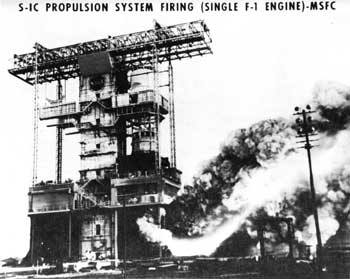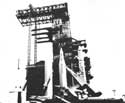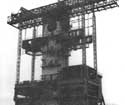.gif)
|
Man in Space
A National Historic Landmark Theme Study |

|
|
Rocket Engine Test Stands |

S-1C Propulsion System Firing, 1966.
(Courtesy of NASA, NASA/Marshall Space Flight Center Facilities Office)
Propulsion and Structural Test Facility
| Name: | Propulsion and Structural Test Facility (Solid Motor Structural Test Facility) |
| Location: | George C. Marshall Space Flight Center, Huntsville, Alabama |
| Owner: | National Aeronautics and Space Administration (NASA) |
| Condition: | Excellent, altered, original location |
| Builder/Architect: | U.S. Army |
| Dates: | 1957-Present |
DESCRIPTION
The Solid Rocket Motor Structural Test Facility (Building #4572) was constructed in 1957. It is in the East Test Area of the Marshall Space Flight Center. This facility is a two-position test stand with a concrete foundation, reinforced concrete load frame, and steel structural frame. The test stand is 175 feet high and 20 feet x 30 feet at its base. The support shop, office space, and terminal room occupy 13,360 square feet of area. The test stand is equipped with a 100-ton overhead crane and a 45-ton gantry crane (Building #4573). Control and instrumentation are provided by the East Test Area Blockhouse and Cable Tunnels (Building #4570), with connections to the computer-controlled data acquisition system in the Structures and Mechanics Laboratory.
One position of the test stand can static fire 1.6-million pounds of thrust stages for engines utilizing LOX/kerosene propellants and can accommodate stages 82 feet x 22 feet. The other position has been modified to accommodate solid rocket booster static testing. Modifications included enlarging and enclosing the west flame trench to accept the test booster.
The Solid Rocket Test Facility is active and is expected to provide continued support to the development and testing of new advanced rocket motors and vehicles for years to come.
STATEMENT OF SIGNIFICANCE
The Solid Motor Structural Test Facility was built by the United States Army in 1957 to support testing of the Redstone and other rockets then under development by the Army Ballistic Missile Agency at Redstone Arsenal. After the establishment of the National Aeronautics and Space Administration the Solid Motor Structural Test Facility was transferred to NASA's George C. Marshall Space Flight Center within the boundaries of the Redstone Arsenal. During the next few years the Marshall Space Flight Center became the primary NASA Center responsible for the development of large launch vehicles and rocket propulsion systems. During the 1960s, under the leadership of Dr. Werner von Braun, the Marshall Space Flight Center developed the Saturn Family of launch vehicles. The Saturn 1 was the launch vehicle for the Pegasus meteoroid detection satellite. The Saturn 1-B was used for Apollo spacecraft development and orbital maneuvers and for the Skylab and Apollo-Soyuz missions. The Saturn V was the launch vehicle for the Earth orbital missions and eventual moon landing missions.
The Solid Rocket Motor Structural Test Facility is one of the oldest rocket motor test facilities at the Marshall Space Flight Center. It has supported testing of the Army Redstone Rocket, the Saturn S-1B vehicle, and F-1 engine of the Saturn 1-C vehicle employed in the Apollo program. After the completion of the Saturn development program one position of the test stand was modified to accommodate static testing for the Solid Rocket booster currently used in the Space Shuttle Program. The Solid Rocket Motor Structural Test Facility, through its continual use and development over the years since 1957, has played a part in the testing of every important rocket developed by the Redstone Arsenal and later the Marshall Space Flight Center. Through its continual use and modification to meet the demands of new programs, it is illustrative of the primary mission assigned to the Army Ballistic Missile Agency and the George C. Marshall Space Flight Center--the development of large launch vehicles and propulsion systems needed to support the American Space Program. The launch of the Apollo missions to the moon were spectacular, but without the support provided by the Marshall Space Flight Center and the years of testing of rocket boosters at the Solid Rocket Motor Test Facility, the American Space Program would never have succeeded.
BIBLIOGRAPHY
Bilstein, Roger B. Stages to Saturn: A Technological History of the Apollo Launch Vehicle. Washington, D.C.: National Aeronautics and Space Administration, 1980.
Brooks, Courtney G., Grimwood, James M. and Swenson, Loyd S. Chariots for Apollo: A History of Manned Lunar Spacecraft. Washington, D.C.: National Aeronautics and Space Administration, 1979.
Draft Historic Properties Report Redstone Arsenal, Alabama with the George C. Marshall Space Flight Center. Silver Spring, Maryland: Building Technology Incorporated, 1983.
Technical Facilities Catalog Vol. III. Washington, D.C.: National Aeronautics and Space Administration, 1974.
PHOTOGRAPHS
(click on the above photographs for a more detailed view)
Last Modified: Mon, Jan 8 2001 10:00:00 am PDT
man-in-space/space9.htm







 Top
Top